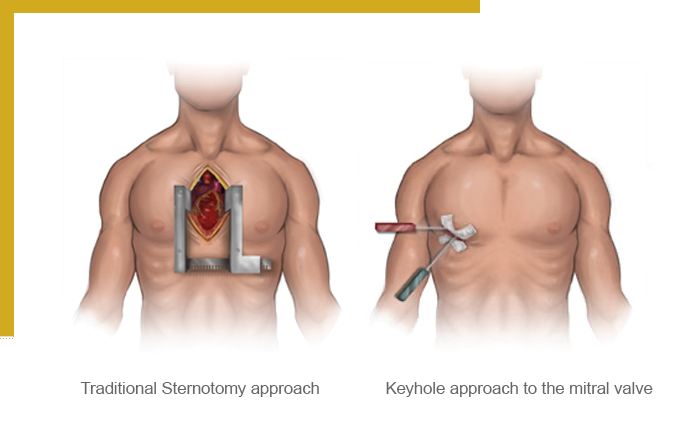Mitral Valve Regurgitation Surgery Recovery Time

One of the most common questions patients ask is about recovery time after the procedure. In this blog post, we will explore the recovery process following different surgical approaches for mitral valve regurgitation and compare their outcomes.
Sternotomy vs. Minithoracotomy: The Two Main Approaches
When it comes to mitral valve repair surgery, there are two primary approaches: conventional sternotomy and minimally invasive minithoracotomy. Let’s dive into each method and discuss their recovery timelines.
Conventional Sternotomy
Sternotomy is the traditional approach for mitral valve repair. It involves making a long incision down the centre the chest and splitting the breastbone to access the heart. This method provides excellent exposure of the heart and allows surgeons to perform complex repairs with ease.
Recovery timeline:
- Hospital stay: Typically 5-7 days
- Return to normal activities: 6-8 weeks
- Full recovery: 3-4 months
The sternotomy approach requires more time for the breastbone to heal, which is why the recovery period is longer. Patients often experience more pain and discomfort in the initial weeks following surgery.
Minimally Invasive Minithoracotomy
Minithoracotomy is a less invasive approach that involves making a small incision (about 2-3 inches) on the right side of the chest. The surgeon uses specialized instruments and a camera to perform the repair through this smaller opening.
Recovery timeline:
- Hospital stay: Usually 3-5 days
- Return to normal activities: 4-6 weeks
- Full recovery: 2-3 months
The minithoracotomy approach generally results in a faster recovery, less pain, and smaller scars compared to sternotomy.
Comparing Recovery: Sternotomy vs. Minithoracotomy
Now, let’s compare these two approaches in terms of recovery and outcomes. The UK Mini Mitral Trial, a groundbreaking randomized clinical trial, compared the effectiveness and safety of minithoracotomy versus sternotomy for mitral valve repair. This study provides valuable insights into the recovery process for both approaches.
Key findings:
- Physical function at 12 weeks: The trial found that minithoracotomy was not superior to sternotomy in terms of physical function recovery at 12 weeks post-surgery. Both groups showed similar improvements in their SF-36 physical function scores.
- Early recovery advantage: Interestingly, the minithoracotomy group demonstrated better recovery from baseline to 6 weeks compared to the sternotomy group. This suggests that patients who undergo minimally invasive surgery may experience faster initial recovery.
- Hospital stay: Patients in the minithoracotomy group had shorter hospital stays and were twice as likely to be discharged early compared to those who underwent sternotomy.
- Physical activity: The minithoracotomy group spent significantly more time engaging in moderate and vigorous physical activities, such as running, walking, and swimming, compared to the sternotomy group.
- Sleep efficiency: Patients who underwent minithoracotomy reported better sleep efficiency during their recovery period.
These findings suggest that while both approaches lead to similar outcomes at 12 weeks, minithoracotomy may offer some advantages in terms of early recovery and quality of life during the initial weeks following surgery.
Other Benefits of Minithoracotomy
In addition to the findings from the UK Mini Mitral Trial, other studies and clinical experience have shown several benefits of the minithoracotomy approach:
- Smaller incisions: The cosmetic advantage of minithoracotomy is significant, with much smaller scars compared to sternotomy.
- Reduced blood loss: Minimally invasive techniques often result in less bleeding during and after surgery.
- Lower risk of infection: Smaller incisions generally mean a lower risk of surgical site infections.
- Faster return to work: Many patients who undergo minithoracotomy can return to work and normal activities sooner than those who have sternotomy.
- Less post-operative pain: The smaller incision typically results in less pain during the recovery period.
- Preserved chest stability: Unlike sternotomy, minithoracotomy doesn’t involve cutting through the breastbone, which helps maintain chest stability during recovery.
Choosing the Right Approach
While minithoracotomy offers several advantages, it’s important to note that not all patients are suitable candidates for this approach. Factors such as the specific type of mitral valve repair needed, the patient’s body habitus, and any previous chest surgeries can influence the choice of surgical technique.As a surgeon, I always discuss both options with my patients, explaining the pros and cons of each approach. The decision is made collaboratively, taking into account the patient’s preferences, overall health, and the complexity of the repair required.
When Surgery Isn’t an Option: MitraClip
For some patients, traditional mitral valve surgery – whether via sternotomy or minithoracotomy – may not be feasible due to high surgical risk. In these cases, a minimally invasive procedure called MitraClip can be an alternative option.

Benefits of MitraClip
- Minimally invasive: The procedure is performed through a small incision in the groin, without the need for open-heart surgery.
- Shorter hospital stay: Patients typically spend only 1-3 days in the hospital following the procedure.
- Faster recovery: Most patients can return to normal activities within a week or two.
- Reduced mortality risk: For high-risk patients, MitraClip has shown a 33% reduction in relative risk of mortality compared to medical therapy alone.
- Fewer hospitalizations: Patients who undergo MitraClip experience a 51% relative risk reduction in heart failure hospitalizations.
- Improved quality of life: MitraClip patients are 2.5 times more likely to experience a large improvement in quality of life compared to those on medical therapy alone.
Drawbacks of MitraClip
- Less complete repair: MitraClip may not achieve as complete a repair as traditional surgery, potentially leading to residual mitral regurgitation.
- Durability concerns: Long-term durability of MitraClip repair may not be as robust as surgical repair, potentially requiring additional interventions in the future.
- Limited applicability: Not all types of mitral valve regurgitation are suitable for MitraClip treatment.
- Potential complications: While generally safe, MitraClip carries risks such as device dislodgement, bleeding, or vascular complications.
Conclusion
Recovering from mitral valve regurgitation surgery is a journey that varies depending on the surgical approach chosen. While conventional sternotomy has been the gold standard for many years, minimally invasive minithoracotomy is gaining popularity due to its potential benefits in terms of early recovery and quality of life.The UK Mini Mitral Trial has shown us that both approaches lead to similar outcomes at 12 weeks, but minithoracotomy may offer advantages in the initial recovery period. As a surgeon, I believe that the choice between sternotomy and minithoracotomy should be tailored to each patient’s individual needs and circumstances.For those who are not candidates for traditional surgery, MitraClip offers a less invasive alternative that can significantly improve symptoms and quality of life. However, it’s important to weigh the benefits against the potential drawbacks and long-term considerations.Ultimately, the goal of any mitral valve intervention is to improve your heart function, alleviate symptoms, and enhance your overall quality of life. By working closely with your healthcare team, you can make an informed decision about the best approach for your specific situation and embark on your recovery journey with confidence.

